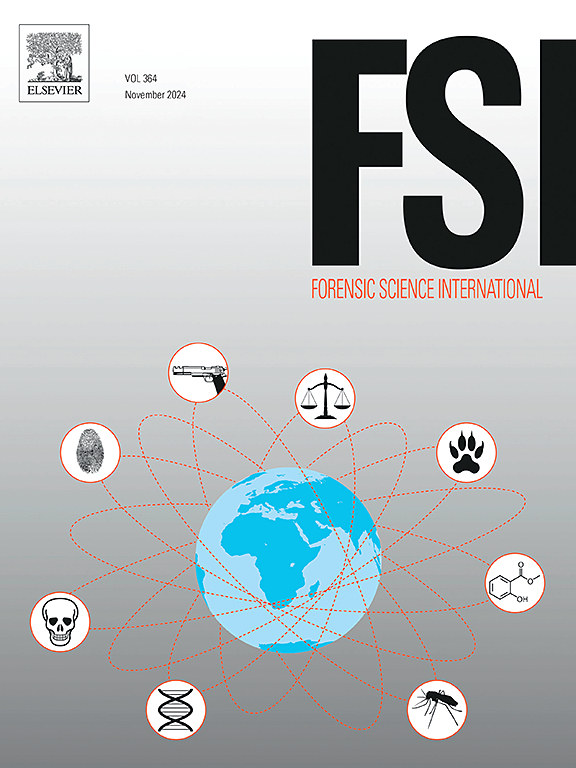T1 and T2 signal appearance of different age stages of intracranial hemorrhage in post-mortem MRI
IF 2.2
3区 医学
Q1 MEDICINE, LEGAL
引用次数: 0
Abstract
Background
In forensic post-mortem medicine, intracranial hemorrhage is a relatively common and usually relevant finding. In recent years, the feasibility of post-mortem MRI (PMMR) for visualization of relevant intracranial findings, such as hemorrhage, has been demonstrated. The aim of this study was to investigate the PMMR T1 and T2 signal behavior of intracranial hemorrhages of different ages and the influence of post-mortem interval and degree of putrefaction on PMMR signal.
Methods
N = 200 forensic cases with natural and traumatic intracranial hemorrhages were examined in T1 and T2 weighted PMMR of the head. Hemorrhage age was determined based on police and/or medical case information and categorized into different age stages (hyperacute: < 12 hours; acute: 12–48 hours; early subacute: 2–7 days; late subacute: 7 days–1 month; chronic: > 1 month). T1w and T2w signal behavior was recorded and correlated according to the assessed individual age stages. Multinomial logistic regression was used to analyze whether signal behavior was influenced by the postmortem interval or the degree of putrefaction as assed by the radiological alteration index (RAI).
Results
In all age groups, predominant signal intensities were observed on both the T1 and T2 weighted images across all different hemorrhage types. The predominant PMMR signals corresponded to the known signal patterns of living patients in clinical MRI. However, deviations from the predominant signal intensity were observed in all age groups. The T1 and T2 signal characteristics of intracranial hemorrhage were not significantly influenced in cases with high RAI respectively advanced putrefaction.
颅内出血不同年龄阶段的死后MRI T1、T2信号表现
背景:在法医验尸医学中,颅内出血是一种相对常见且通常相关的发现。近年来,尸检MRI (PMMR)可视化相关颅内表现(如出血)的可行性已得到证实。本研究旨在探讨不同年龄颅内出血患者的PMMR T1、T2信号行为,以及死亡时间和腐烂程度对PMMR信号的影响。方法对200例自然出血和外伤性颅内出血的法医患者进行T1和T2加权头部PMMR检查[ = ]。出血年龄是根据警方和/或医疗病例信息确定的,并分为不同的年龄阶段(超急性期:<; 12小时;急性:12-48 小时;早期亚急性:2-7天;亚急性晚期:7天- 1个月;慢性:比;1个月)。记录T1w和T2w信号行为,并根据评估的个体年龄阶段进行相关性分析。采用多项逻辑回归分析信号行为是否受到死后时间或放射性改变指数(RAI)所反映的腐烂程度的影响。结果在所有年龄组中,不同出血类型的T1和T2加权图像上均可见明显的信号强度。主要的PMMR信号与临床MRI中已知的活着患者的信号模式相对应。然而,在所有年龄组中都观察到与主要信号强度的偏差。颅内出血的T1和T2信号特征在RAI高的情况下均无明显影响。
本文章由计算机程序翻译,如有差异,请以英文原文为准。
求助全文
约1分钟内获得全文
求助全文
来源期刊

Forensic science international
医学-医学:法
CiteScore
5.00
自引率
9.10%
发文量
285
审稿时长
49 days
期刊介绍:
Forensic Science International is the flagship journal in the prestigious Forensic Science International family, publishing the most innovative, cutting-edge, and influential contributions across the forensic sciences. Fields include: forensic pathology and histochemistry, chemistry, biochemistry and toxicology, biology, serology, odontology, psychiatry, anthropology, digital forensics, the physical sciences, firearms, and document examination, as well as investigations of value to public health in its broadest sense, and the important marginal area where science and medicine interact with the law.
The journal publishes:
Case Reports
Commentaries
Letters to the Editor
Original Research Papers (Regular Papers)
Rapid Communications
Review Articles
Technical Notes.
 求助内容:
求助内容: 应助结果提醒方式:
应助结果提醒方式:


